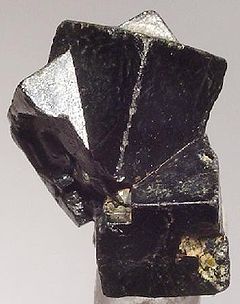Thorianite
| Thorianite | |
|---|---|

Group of interpenetrating twinned thorite crystals from Ambatofotsy, Madagascar (size: 1.6 x 1.4 x 1.3 cm)
|
|
| General | |
| Category | Oxide mineral |
|
Formula (repeating unit) |
Thorium oxide, ThO2 |
| Strunz classification | 4.DL.05 |
| Crystal system | Isometric |
| Crystal class | Hexoctahedral (m3m) H-M symbol: (4/m 3 2/m) |
| Space group | Fm3m |
| Unit cell | a = 5.595 Å; Z = 4 |
| Identification | |
| Color | Dark gray, brown-black |
| Crystal habit | Cubic crystals, usually rounded to some degree in detrital deposits |
| Twinning | Penetration twins on {111} common |
| Cleavage | Poor/Indistinct |
| Fracture | Irregular to uneven, sub-conchoidal |
| Mohs scale hardness | 6.5 - 7 |
| Luster | Resinous, sub-metallic |
| Streak | Grey, grey green to black |
| Diaphaneity | Opaque, translucent on thin edges |
| Specific gravity | 9.7 |
| Optical properties | Isotropic |
| Refractive index | n = 2.20 – 2.35 |
| References | |
Thorianite is a rare thorium oxide mineral, ThO2. It was originally described by Ananda Coomaraswamy in 1904 as uraninite, but recognized as a new species by Wyndham R. Dunstan. It was so named on account of its high percentage of thorium; it also contains the oxides of uranium, lanthanum, cerium, praseodymium and neodymium. Helium is present, and the mineral is slightly less radioactive than pitchblende, but is harder to shield due to its high energy gamma rays. It is common in the alluvial gem-gravels of Sri Lanka, where it occurs mostly as water worn, small, heavy, black, cubic crystals. The largest crystals are usually near 1.5 cm. Larger crystals, up to 6 cm (2.4 in), have been reported from Madagascar.
Based on color, specific gravity and composition three types of thorianite are distinguished:
Thorianite and uraninite form a complete solid solution series in synthetic and natural material. The division between the two species is at Th:U = 1:1 with U possibly making up to 46.50% and Th ranging up to 87.9%.Rare earths, chiefly Ce, substitute for Th in amounts up to 8% by weight. Ce is probably present as Ce4+. Complete series is known in synthetic material between CeO2 - PrO2 - ThO2 - UO2. Small amounts of Fe3+ and Zr also may be isomorphous with Th. Pb present is probably radiogenic.
Usually found in alluvial deposits, beach sands heavy mineral placers and pegmatites.
...
Wikipedia
